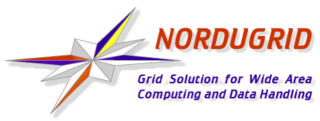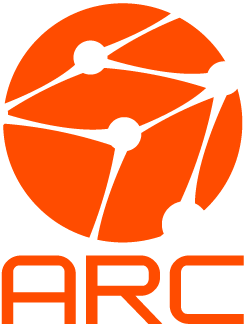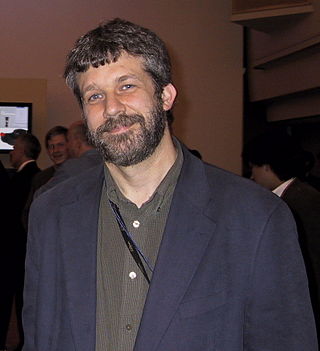Related Research Articles
Grid computing is the use of widely distributed computer resources to reach a common goal. A computing grid can be thought of as a distributed system with non-interactive workloads that involve many files. Grid computing is distinguished from conventional high-performance computing systems such as cluster computing in that grid computers have each node set to perform a different task/application. Grid computers also tend to be more heterogeneous and geographically dispersed than cluster computers. Although a single grid can be dedicated to a particular application, commonly a grid is used for a variety of purposes. Grids are often constructed with general-purpose grid middleware software libraries. Grid sizes can be quite large.
UNICORE (UNiform Interface to COmputing REsources) is a grid computing technology for resources such as supercomputers or cluster systems and information stored in databases. UNICORE was developed in two projects funded by the German ministry for education and research (BMBF). In European-funded projects UNICORE evolved to a middleware system used at several supercomputer centers. UNICORE served as a basis in other research projects. The UNICORE technology is open source under BSD licence and available at SourceForge.

David Pope Anderson is an American research scientist at the Space Sciences Laboratory, at the University of California, Berkeley, and an adjunct professor of computer science at the University of Houston. Anderson leads the SETI@home, BOINC, Bossa, and Bolt software projects.

NorduGrid is a collaboration aiming at development, maintenance and support of the free Grid middleware, known as the Advanced Resource Connector (ARC).

Advanced Resource Connector (ARC) is a grid computing middleware introduced by NorduGrid. It provides a common interface for submission of computational tasks to different distributed computing systems and thus can enable grid infrastructures of varying size and complexity. The set of services and utilities providing the interface is known as ARC Computing Element (ARC-CE). ARC-CE functionality includes data staging and caching, developed in order to support data-intensive distributed computing. ARC is an open source software distributed under the Apache License 2.0.

Charlie Catlett is a senior computer scientist at Argonne National Laboratory and a visiting senior fellow at the Mansueto Institute for Urban Innovation at the University of Chicago. From 2020 to 2022 he was a senior research scientist at the University of Illinois Discovery Partners Institute. He was previously a senior computer scientist at Argonne National Laboratory and a senior fellow in the Computation Institute, a joint institute of Argonne National Laboratory and The University of Chicago, and a senior fellow at the University of Chicago's Harris School of Public Policy.
The D-Grid Initiative was a government project to fund computer infrastructure for education and research (e-Science) in Germany. It uses the term grid computing. D-Grid started September 1, 2005 with six community projects and an integration project (DGI) as well as several partner projects.

A message broker is an intermediary computer program module that translates a message from the formal messaging protocol of the sender to the formal messaging protocol of the receiver. Message brokers are elements in telecommunication or computer networks where software applications communicate by exchanging formally-defined messages. Message brokers are a building block of message-oriented middleware (MOM) but are typically not a replacement for traditional middleware like MOM and remote procedure call (RPC).

The Open Grid Forum (OGF) is a community of users, developers, and vendors for standardization of grid computing. It was formed in 2006 in a merger of the Global Grid Forum and the Enterprise Grid Alliance. The OGF models its process on the Internet Engineering Task Force (IETF), and produces documents with many acronyms such as OGSA, OGSI, and JSDL.
Configurable Network Computing or CNC is JD Edwards's (JDE) client–server proprietary architecture and methodology. Now a division of the Oracle Corporation, Oracle continues to sponsor the ongoing development of the JD Edwards Enterprise Resource Planning (ERP) system, While highly flexible, the CNC architecture is proprietary and, as such, it cannot be exported to any other systems. While the CNC architecture's chief 'Claim to fame', insulation of applications from the underlying database and operating systems, were largely superseded by modern web-based technology, nevertheless CNC technology continues to be at the heart of both JD Edwards' One World and Enterprise One architecture and is planned to play a significant role Oracle's developing fusion architecture initiative. While a proprietary architecture, CNC is neither an Oracle nor JDE product offering. The term CNC also refers to the systems analysts who install, maintain, manage and enhance this architecture. CNC's are also one of the three technical areas in the JD Edwards Enterprise Resource Planning ERP which include developer/report writer and functional/business analysts.
A reliable multicast is any computer networking protocol that provides a reliable sequence of packets to multiple recipients simultaneously, making it suitable for applications such as multi-receiver file transfer.

Cloud computing is the on-demand availability of computer system resources, especially data storage and computing power, without direct active management by the user. Large clouds often have functions distributed over multiple locations, each of which is a data center. Cloud computing relies on sharing of resources to achieve coherence and typically uses a pay-as-you-go model, which can help in reducing capital expenses but may also lead to unexpected operating expenses for users.

The P-GRADE Grid Portal was software for web portals to manage the life-cycle of executing a parallel application in grid computing. It was developed by the MTA SZTAKI Laboratory of Parallel and Distributed Systems (LPDS) at the Hungarian Academy of Sciences, Hungary, from around 2005 through 2010.
HP Cloud Service Automation is cloud management software from Hewlett Packard Enterprise (HPE) that is used by companies and government agencies to automate the management of cloud-based IT-as-a-service, from order, to provision, and retirement. HP Cloud Service Automation orchestrates the provisioning and deployment of complex IT services such as of databases, middleware, and packaged applications. The software speeds deployment of application-based services across hybrid cloud delivery platforms and traditional IT environments.
The SHIWA project within grid computing was a project led by the LPDS of MTA Computer and Automation Research Institute. The project coordinator was Prof. Dr. Peter Kacsuk. It started on the 1st of July 2010 and lasted two years. SHIWA was supported by a grant from the European Commission's FP7 INFRASTRUCTURES-2010-2 call under grant agreement n°261585.
Middleware is a type of computer software program that provides services to software applications beyond those available from the operating system. It can be described as "software glue".
Klara Nahrstedt is the Ralph and Catherine Fisher Professor of Computer Science at the University of Illinois at Urbana–Champaign, and directs the Coordinated Science Laboratory there. Her research concerns multimedia, quality of service, and middleware.
Michela Taufer is an Italian-American computer scientist and holds the Jack Dongarra Professorship in High Performance Computing within the Department of Electrical Engineering and Computer Science at the University of Tennessee, Knoxville. She is an ACM Distinguished Scientist and an IEEE Senior Member. In 2021, together with a team al Lawrence Livermore National Laboratory, she earned a R&D 100 Award for the Flux workload management software framework in the Software/Services category.
Gennaro "Jerry" Cuomo is an American software engineer who has worked for IBM since 1987. Holding the title of IBM Fellow, Cuomo is known as one of the founding fathers of IBM WebSphere Software, a software framework and middleware that hosts Java-based web applications.
Valérie Issarny was a Director of Research at the National Institute for Research in Digital Science and Technology (INRIA), France. Issarny was known for her research in middleware solutions for distributed collaborative services, including mobile services deployed over smartphones that interact with sensors.
References
- 1 2 3 Tamar Eilam, IBM Research, retrieved 2019-09-16
- ↑ Tamar Eilam at the Mathematics Genealogy Project
- 1 2 3 "Tamar Eilam, IBM, 2016 Working Mother of the Year", Working Mother, August 13, 2016